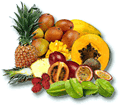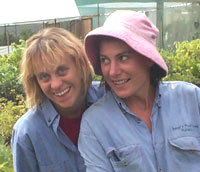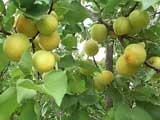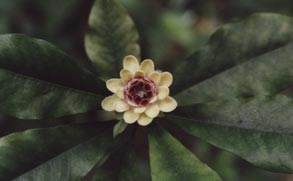
March 2004
The Daley News
Change of Hands at the Nursery
Emma here!
 Some in house nursery news for you. Having joined the nursery team here at Daleys at the turn of the century, I have been on the other end of the phone to many of you and preparing the Daleys newsletter here for the last two years. Some of our readers may remember the tales of my travels to the Solomon Islands in the January 2003 Newsletter. Well a year later, here I am again, packing my bags for the Solomons but this time for a few years.
Some in house nursery news for you. Having joined the nursery team here at Daleys at the turn of the century, I have been on the other end of the phone to many of you and preparing the Daleys newsletter here for the last two years. Some of our readers may remember the tales of my travels to the Solomon Islands in the January 2003 Newsletter. Well a year later, here I am again, packing my bags for the Solomons but this time for a few years.
While undoubtedly sad about leaving the nursery here (if only I could take it all with me!) I am very excited about the new adventures to come. I will be working in the Islands as an Australian Volunteer. My role is to support young adults in rural areas to establish small businesses/livelihoods in the field of Sustainable Agriculture.
My many years as a tropical fruit fan here in Australia will certainly be a great foundation for this new role as the Kastom Garden program (for which I shall be working) has identified great interest for setting up small fruit and nut tree nurseries. I do hope to remain in contact with the numerous Australian Green thumbs that I have befriended over the years through working at Daleys and will dearly miss being part of such a fruitful business. Keep your eyes on the future newsletters, as I will be looking forward to sharing with you the growth rate of all the tropical trees that never quite made it through the Northern NSW winter. Lookim uifala next taem nau.
Kath takes the baton
Welcome to March 2004, before I introduce myself I’d like to bid farewell to Emma my friend and team mate. I know I can speak for us all here at Daleys in wishing you every success in all you do. You inspire us and keep us smiling, have a beautiful  future. Thanks a million for being a part of our team.
future. Thanks a million for being a part of our team.
As for me, my name is Kath and I am trying on Emma’s old shoes for size. Those of you who visit our retail section will probably recognise me and my pink hat. My passion is for the bush and I satisfy this by working with my partner on our bit of land near Kyogle. We have spent the last couple of years removing a canopy of lantana and vines, and are totally amazed by the variety of native species that are happily regenerating in our little corner of the world. Believe me when I say that I am enthusiastic about rainforest trees and bush foods.
My knowledge of fruit trees is burgeoning and I fully appreciate that many of you are old hands at this. I welcome any feedback that you may have to offer and hope that you continue to find The Daley news an informative and interesting space.
.....Our Favourites for March.....
APRICOT - Prunus armeniaca
The apricot is native to the mountains of Northern China, the Himalaya and temperate Asia. Ever since the discovery of its luscious fruit it has been widely cultivated. Related to the peach the apricot is a soft fleshed fruit that is best eaten picked straight from the tree to appreciate the full delicacy of its flavour, much of which is lost in commercial production due to it having to be picked unripe in order to survive transportation. The kernels of some varieties are edible and resemble bitter almonds for which they are often substituted. Apricot kernels are also pressed for their oil; this is used in place of almond oil for it is less expensive. It is used considerably in cosmetic and skin care products. Australia is the world’s second largest producer of dried apricots after Turkey. Apricots are an excellent source of beta-carotene, (vitamin A), also providing vitamin C, iron, potassium and fibre among other things. They are extremely versatile in the kitchen and are enjoyed in sweet and savory dishes as well as snacks and preserves. Every good kitchen deserves an apricot
Our Exotic Delight of the Month
 YLANG YLANG- Cananga odorata
YLANG YLANG- Cananga odorata
pronounced ilang ilang
The highly ornamental tree Ylang Ylang is a member of the custard apple family, Annonaceae. It is not only extremely beautiful but is also widely known for having many beneficial properties. People have traditionally used the seductive scent of the flowers for a sense of well-being and as an aphrodisiac.
Ylang Ylang is native to the tropics, in particular to Malaysia, Indonesia and is thought to originate in the Philippines where in the local Tagalog language the name Ylang Ylang means, “flower of flowers”. It is known as the perfume tree and was a key flower essence for the Chanel no. 5 scent. The curious flowers are large and beautiful, their lime-green colour makes them inconspicuous compared with the intensity of their fragrance. They also yield a valuable essential oil that is widely used in cosmetics, soap, perfumery and aromatherapy. The exotic scent of the Ylang Ylang is both calming and euphoric. A few drops of the oil in the bath are said to sooth and relax the body and mind. I imagine a bath with a scattering of blossoms would be even more exquisite.
As a tropical tree Ylang Ylang reaches up to 20m in height, being smaller in cooler districts. It has long drooping textured foliage reminiscent of its custard apple relations. The branches droop down then swoop up at the ends, they are brittle. It will look beautiful and will be happy to flower in a container but it must have temperatures consistently over zero or it will die back to the ground. It is very frost sensitive and minus two degrees will kill it. If kept in a pot it will require adequate water and fertilizer in the warmer months. As an ornamental garden plant Ylang Ylang will delight any gardener who is partial to strongly scented plants. The flowers can be picked and used to scent rooms, bathwater and linen. They are ideal for adding to tired pot pouri bowls. One blossom will enliven a space in no time.
The scent of Ylang Ylang, the flower of flowers, is said to stimulate the part of the brain that releases endorphins, creating a sense of well-being. Whatever it is about the Ylang Ylang, it seems to be that it makes people feel good.
Our Bushfood of the Month
BOLWARRA- Eupomatia laurina
 The Bolwarra is a true dinosaur tree. It belongs to an ancient family with only one other member Eupomatia bennettii, the small bolwarra (see photo). Both species have extraordinary flowers that open for only one day. In this time the flowers must be pollinated by small weevils in order to set fruit. The bolwarra has a wide distribution in all types of rainforest along the East coast of Australia from southern Victoria to North Queensland.
The Bolwarra is a true dinosaur tree. It belongs to an ancient family with only one other member Eupomatia bennettii, the small bolwarra (see photo). Both species have extraordinary flowers that open for only one day. In this time the flowers must be pollinated by small weevils in order to set fruit. The bolwarra has a wide distribution in all types of rainforest along the East coast of Australia from southern Victoria to North Queensland.
The dark green to black branchlets and shiny green foliage along arching stems combine with its great interest to science to make this a wonderful native species to grow. It is well suited to cultivation and will adapt to most shady sites. It can look good in a pot and will respond to pruning.
As the flower buds develop, they are reminiscent of gum nuts. A cap on the top eventually opens to reveal petals like staminodes. This species is a living example of the most primitive flowers. In the case of one I saw recently these staminodes were waving like a sea anemone, on close inspection I saw the flower was filled with tiny weevils working their magic.
The aromatic and sweet fruits of the Bolwarra are ripe in autumn and winter when they are soft and yellow green. The sweet spicy clear flesh surrounds numerous seeds and can be dried or preserved. It is reminiscent of a guava hence the alternative common name Native Guava. This species is a fascinating addition to any native garden and a must for all bush foods enthusiasts.
When purchasing any of the above plants in your next mail order, through the month of March, you are entitled to receive 5 free tubestock of your choice in addition to your order.
The trees listed above and many more are available at Daleys Nursery. See our website at https://www.daleysfruit.com.au.htm and go straight to the shopping trolley to order these plants or call in and see Kath at the Nursery for more information.
Apricot, Avocado and Almond Salad on Greens |
|
|
Ingredients:
|
|
A Weed or Not a Weed
This page is aimed at informing the fruit enthusiast of appropriate cautions and clearing some of the mystery about the weed-iness of some of fruiting plants. It is not our intention to concern the gardener with this information, but to make them aware of the possibility that without attentive cultivation and care, some plants can spread or multiply creating a nuisance within their own garden and possibly neighbouring areas.
One of the roles of a gardener is to have a caring and considerate relationship to their ‘patch’ and the surrounding environment. Defining a weed is not an easy task. What is a weed in one place may be a tame and contented plant somewhere else. This difference may not only occur from one state to another but on a smaller scale from one locality to another in the same region depending on the surrounding environment of the plant. Therefore a keen eye for observation and a thoughtful approach is worthwhile cultivating along with your soil.
A weed has been defined as ‘plant out of place’. An environmental weed is descibed as 'a plant which, through various methods of disribution and proliferation have become a threat to the survival of native plants and animals.' An Agricultural weed ‘is a plant growing wild, especially in cultivated ground, to the exclusion or injury of the desired crop’ however some weeds which are a cultivated crop can also be classified by government agencies as weeds, which can undoubtedly lead to confusion. Coffee (Coffee arabica) is one such example in Northern NSW, while there is concern for it weed potential among remanent stands of native vegetation, it is also carries great interest cultivated as an agricultural crop.
Each council has different concerns for problems weeds in their area. For more information relating to your own suburb or district contact the Parks and Gardens Office at your local council. In addition to this we would like to advise you of the following plants as those that carry cautions in certain areas.
ORNAMENTALS
Some of our favourite ornamentals carry concerns as invasive weeds such as cosmos, cornflowers, bougainvillia, forget-me-knots, as well some very popular larger ornamental trees such as the cadaghi and the liquid amber.
Comfrey (Symphytum officinale)
This hairy herb is very popular both as an ornamental, a medicinal herb and favoured by permaculturalist as an edging plants and a nutritious addition and accelerator to composts or liquid fertilizers. These plants grow in clumps reaching 1-1.5m hight with an indefinite spread. Once planted, it can be very difficult to remove as remaining root sections will re-shoot readily. In some areas it has also been known to self seed.
Golden Trumpet Tree (Tabebuai chrysantha)
Very popular throughout the 70-90’s as a highly ornamental tree with large trumpet shaped yellow flowers. The tree can continue to sucker from the root structure for years after being removed. To be avoided in the subtropics.
Liquid Amber Sweet Gum (Liquidambar styraciflua)
Many people might consider this an odd inclusion. This spectacular deciduous ornamental tree is grown for its brilliant autumn foliage and is frequently planted in gardens, as street trees and occasionally in pasture areas. The fruiting pods, borne in the spring, of the liquidambar contain winged seeds that are carried by wind and self seed reasonably easily.
Silky Oaks (Grevillia robusta)
Very popular native (local to Northern NSW and Southern QLD) as it is very fast growing and frost hardy. It is useful in revegetation and favoured for its beautiful timber. This tree is of concern mostly to southern NSW region where its ability to self seed and its vigour can lead it to dominate other native vegetation.
Sweet Pittosporum (Pittosporum undulatum)
While this is an Australian native, it can grow with such vigour that it can outgrow other native species in the area. Its hardiness as well as its sweet scented flowers have led this plant to be widely used for horticultural purposes in many localities. The sticky seeds are very attractive to birds, which ingest them and spread them further afield.
EDIBLE PLANTS
The following Edible plants have some weed concerns in some areas of Australia. Click on the plant name for a link for more information.
Edible Asparagus (Asparagus officinalis)
Brazillian Cherry (Eugenia uniflora
Candle Nut (Aleurites molucanna)
Cape Gooseberry (Physallis peruvian)
Cherry guava (Psidium cattleianum)
Keriberry (Rubus rugosus var. thwaitsii)
Please remember that some trees can need nurturing to survive in some areas and grow away with vigour in others. For more information please see the Bush Friendly Nursery Scheme website. http://www.bfns.org.au
Next Issue
Cawongala case study for
Forest regeneration






 Apricot Viniagrette:
Apricot Viniagrette: